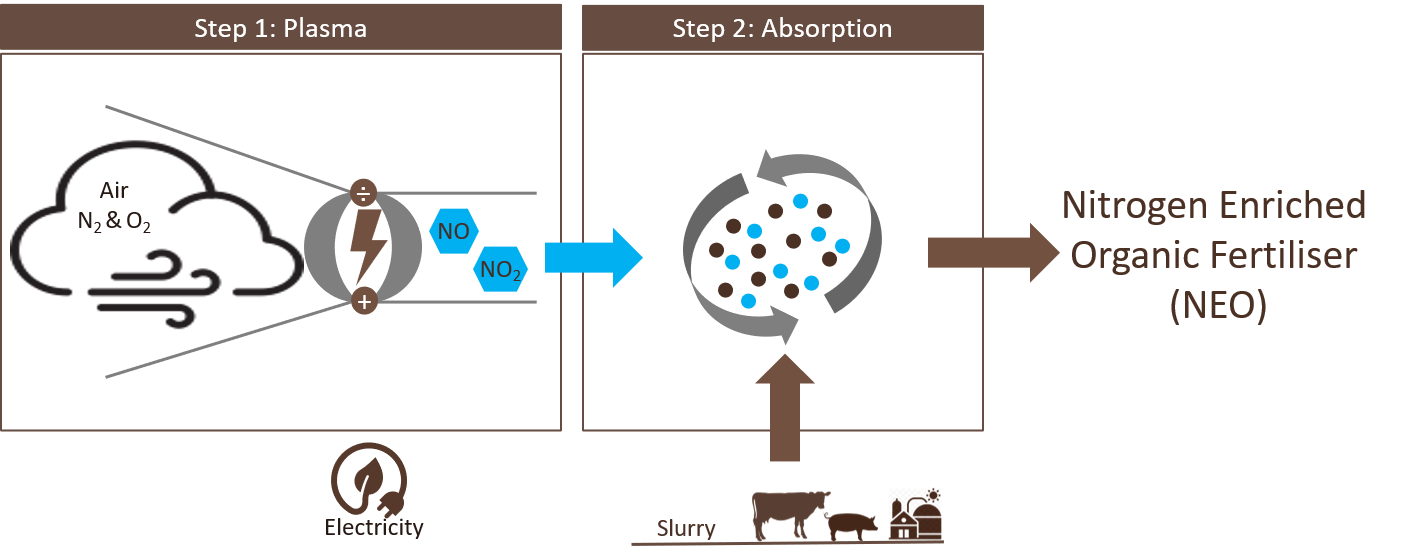“How does it work?” is a question we often get. It is actually quite simple, even if N2 Applied’s underlying technology is complex and innovative. In this blog we explain how our technology works, what the effects are and why we have developed it.
So, how does it work?
We have built a machine – we call it a N2 Unit – that uses only electricity and air to process liquid material like cow or pig slurry and turn it into Nitrogen Enriched Organic fertiliser (NEO). As long as it is liquid organic material, we can treat it. Besides cow or pig slurry this can be digestate from an Anaerobic Digestion (biogas) plant or other organic waste streams.

The great thing about N2 Applied’s solution is that we make use of the air around us. This air contains around 78 percent nitrogen and 22 percent oxygen. The process works in two steps. In step 1 we use electricity to split the nitrogen and oxygen molecules in the air and form a nitrogen oxides (NOx) gas. We use plasma technology for this step. The same thing happens when there is lightning in the air, where the electricity of a stroke of lightning splits the air molecules. In step 2 we mix or absorb the nitrogen oxides (NOx) gas into the liquid stream where it becomes an efficient fertiliser.

What effects does it have?
The most important effects of treating slurry or biogas digestate in a N2 Unit are:
- Increasing the nitrogen content by adding nitrates to the liquid, roughly doubling the ammonia-N content.
- Stopping ammonia and methane emissions from storage and field application of slurry and digestate.
- Stopping the bad smell of the liquid substance.
Reducing ammonia emissions is key in preventing air pollution as one of the main precursor gasses in the formation of particulate matter (PM2.5). Therefore, an important positive effect of our solution is related to public health. Additionally the reduction of ammonia and methane emissions lead – together with substitution of chemical fertilisers on the farm – to a significantly improved carbon footprint of livestock farms. Producing extra nitrogen and keeping the nitrogen from ammonia available for plant uptake instead of disappearing into air, enables the farmer to buy less chemical nitrogen fertilisers. The efficient nitrogen in our organic-based NEO fertiliser is optimal for plant uptake, which increases the growth of the crops, providing the same yield as chemical fertiliser, at competitive cost. Reducing the smell is a bonus benefit, turning a bad smell into what some characterise a scent of dark chocolate! I haven’t tasted it though.
Why do we do it?
It is our ambition to improve global food production by increasing yield and reducing emission at the same time. In essence, we change the current practice of an inefficient and polluting linear chemical fertiliser chain into an improved circular future practice on the farm. We shift centralised fossil-based production to local on-farm production using renewable energy. And that is a much-needed gamechanger!
30 years from now, we will have a global population of ten billion people. At the same time, we know that we will not have access to more arable land, which means we will need to increase food production massively compared to the current situation. This cannot be achieved without the use of fertilisers, but we need to provide fertilisers ensuring a sustainable food production. At N2 Applied we contribute to this challenge.



